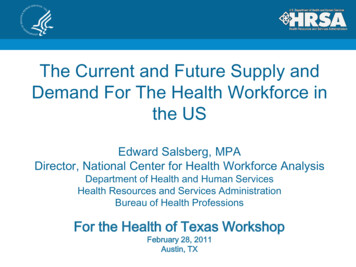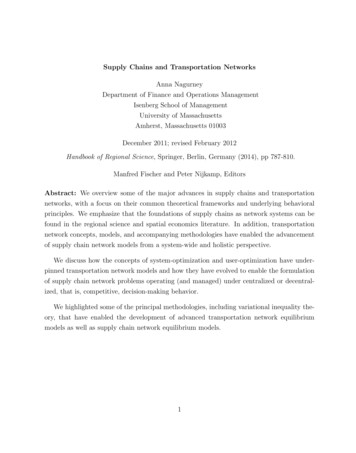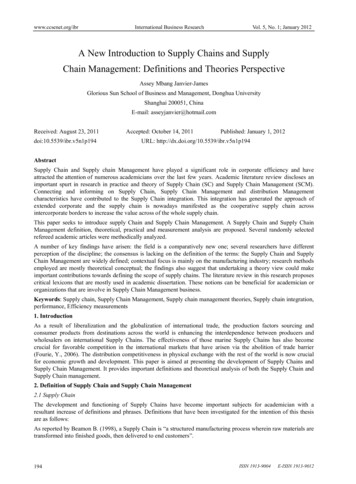
Transcription
The Current and Future Supply andDemand For The Health Workforce inthe USEdward Salsberg, MPADirector, National Center for Health Workforce AnalysisDepartment of Health and Human ServicesHealth Resources and Services AdministrationBureau of Health ProfessionsFor the Health of Texas WorkshopFebruary 28, 2011Austin, TX
Overview The Framework for Health Workforce “Planning” National Health Employment Trends The Expected Shortage The Change Imperative Implications
Key National HealthWorkforce Questions1. Will there be enough physicians, nurses andother health workers? If not: What can we do to increase the supply?What can we do to get these workers to the highestneed areas?What can we do to make better use of physiciansand other health professionals?2. What can we do to assure access?3. What can be done to slow the increase incosts?
The New National HealthWorkforce Infrastructure National Health Care Workforce Commission National Center for Health Workforce Analysis State Health Care Workforce DevelopmentGrantees Health Care Workforce Assessment
The US Approach to HealthWorkforce “Planning” Focus on data collection, analysis, and research Widespread dissemination of data, analyses,and information Federal-state partnerships Increasing attention to evaluation andlongitudinal tracking Inter-professional planning and strategies
National Center for Health Workforce Analysis:Approach and Activities Build on existing sources of data including fromprofessional associations, states, and federalagencies Build national capacity for data collection andanalysis including within professional associationsand states Develop and promote a national uniform minimumdata set Support research to better understand current andfuture workforce needs and dynamics
Workforce Challenges General shortages health personnel includingphysicians and nurses; some specific concerns: Primary Care; Chronic and Long Term Care; Behavioral Health Mal-distribution of existing workforce Barriers to health personnel working at the top oftheir competency Increasing need for workforce diversity Implementing inter-professional educationand practice Planning for an uncertain future
National Health EmploymentTrends
Hospitals Employ More Than OneThird of Health Care WorkersHealth Care Employment by SettingOtherAmbulatory19%Home HealthHospitals34%8%17%Offices ofPhysicians22%Nursing & ResidentialCare FacilitiesSource: Altarum Institute, Health Market Insights from the BLS January 2011 Employment Data.
2000-2008: Health Care JobsFar Outpace the Economy Total U.S. employment grew by 3.7% across 2000–2008; health careemployment grew 30.1% Hospitals experienced slower employment growth than otherhealthcare settingsEmployment Growth By 3%15.4%Hospitals,Nursing CarePublic ome CarePrivateSource: Center for Workforce Studies, SUNY Albany Analysis of BLS data.
Even in Recession, Healthcare Jobs Grew Though hospitals added the largest absolute number of jobs, growth on apercent basis lagged behindHospitals added 33,600 jobs across the last year; in contrast, physician officesadded 26,000Growth in Healthcare Employment by Setting,Jan. 2010 - Jan. ffices ofOutpatient CarePhysiciansCentersHome HealthNursing andCare Services Residential CareFacilitiesSource: Altarum Institute, Health Market Insights from the BLS January 2011 Employment Data.
Demand for Health CareOccupations Will Continue to GrowProjected Increase, 2008 - 2018Occupational therapist assistants30%30%Pharmacy technicians31%31%Physical therapist assistants33%34%Dental assistants36%36%Physical therapist aides36%39%Medical scientists (ex. epidemiologists)40%46%Home health aides50%0%10%Source:20%30%40%50%60%Bureau of Labor Statistics Monthly LaborReview, November 2009.
The Expected Shortage
Drivers of Future Demands for Services Population growth U.S. Population to grow by 30 million in the next decade1 Aging of the Population; concomitant increase inmajor/chronic illness and subsequent demand2 Baby boom generation Medical advances and successes2 Life Style factors3 Increase in chronic diseases Insurance coverage expansion41U.S.Census Bureau “Projections of the Population and Components of Change for the United States: 2010 to 2050”of Labor Statistics “Career Guide to Industries, 2010-2011: Healthcare”3CDC “Chronic Diseases and Health Promotion”4Affordable Care Act2Bureau
Most Major Illnesses Very Age SensitiveCancer Incidence Rates (per 100k pop.)by Age, 2002-2006FemaleAge GroupData present age-specific invasive cancer incidence rates (new cases per 100,000 pop.) for the United Sates, 2002-2006.Source: AAMC Center for Workforce Studies analysis of National Cancer Institute, SEER Cancer Statistics Review, 1975-2006(published 2009).
The Expansion of Insurance Coverage isLikely to Have a Significant Impact in TexasTexas25.7%New ont9.6%Wisconsin9.6%Minnesota8.7%HawaiiThe States with the Highest andLowest Rates of Un-insured, : Current Population Survey (Prepared by NCHWA, February 2011)
Visit Rate By Insurance Type, 2007Source: AAMC Center for Workforce Studies analysis of 2007 NAMCS and NHAMCS Public UseData File (primary expected source of payment variable), Summary Health Statistics for the U.S.Population: National Health Interview Survey, 2007.
Drivers of Future Physician Supply Slow increase in GME positions An aging physician workforce Life style and gender mix Productivity impacted by team structure (PAs, NPs),service delivery mechanisms, HIT/EMRSource: Michael J. Dill & Edward S. Salsberg. The Complexities of Physician Supply and Demand :Projections Through 2025 ( AAMC November 2008).
The Change Imperative
The Change Imperative Unsustainable cost increases Health workforce shortages New models of care: accountable careorganizations (ACOs), patient-centered medicalhomes New approaches to financing including bundledpayments Increasing consumer involvement Dynamic and expanding role of HITSource: National Center for Health Workforce Analysis
10% of the Pop Account for 60% of the Costs!Percentage of total U.S. expenditures100%Percent of Health Care Expenditures Accounted forBy Top Spenders, 2005 – 200695.7%81.9%80%59.5%60%44.0%40%20%18.7%0%Top 1%Top 5%Top 10%Top 25%Percentage of the Population, by Spending BracketTop 50%Source: AAMC Center for Workforce Studies analysis of Cohen, S.B., Rohde, F. (2009)The Concentration in Health Expendituresover a Two Year Time Interval, Estimates for the U.S. Population, 2005–2006. MEPS Statistical Brief #244. Figure One. (U.S.civilian non-institutionalized population).
Most Plausible Scenario950,000900,000FTE PhysiciansMost plausible Most plausible supply650,00020052010201520202025 Projections do not take into account health reform Assumes: a rise in utilization rates; shift in work schedules; anincrease in productivity; moderate growth in GME (27,600 newresidents/year)Source: Michael J. Dill & Edward S. Salsberg. The Complexities of Physician Supply and Demand :Projections Through 2025 ( AAMC November 2008).
Number of NPs Growing RapidlyGrowth in NP Graduates, 2000 - 200910,0009,200NP 0052006200720082009Source: American Association of Colleges of Nursing 2000-2009 Annual Surveys
Number of PAs of Growing RapidlyNewly Licensed PAs, 2000 - 20106,500Newly Licensed 2354,3374,0514,6544,9894,3934,0093,5001999 2000 2001 2002 2003 2004 2005 2006 2007 2008 2009 2010 2011Source:National Commission on Certification of Physician Assistants“Certified Physician Assistant Population Trends (PA-Cs)”
Workforce Composition:The Growth of Non-Physician Clinicians109Direct Patient Care Providers by Type,Supply and Production98765Physicians54332210Currently PracticingSource: National Center for Health Workforce AnalysisNew Providers/YearPAs/NPs
Use of Hospitalists Is IncreasingPercent of Internal Medicine Physicians WhoAre Hospitalists, by 3%8.3%5.0%2.5%5.0%0.0% 40 yrs40-49 yrsGeneral Internal Medicine50-59 yrs60 yrsInternal Medicine SubspecialistsSource: AAMC 2009 Physician Survey on Primary Care
Possible Members of theHealth Care Team of the FuturePhysiciansNurse practitionersPhysician assistantsPsychologistsOptometristsRegistered NursesPharmacistsCase ManagersNutritionists/DieticiansPhysical TherapistsCommunity Health Workers And more
Implications Cost pressures and shortages will encourageinnovation and systems redesign Strong incentives to make better use of existingworkforce Shift to team-based care and inter-professionalpractice Shift care to lower cost settingsSource: National Center for Health Workforce Analysis
Implications (2) Increasing competition for practitioners Closer alignment of education and practice Pressure to reduce time and cost of education Need for better health workforce data andinformationSource: National Center for Health Workforce Analysis
Relevant Federal Programs and Policies Increased funding for health professionseducation and training Expansion of National Health Service Corp andcommunity health centers Support for service delivery innovations National Center for Health Workforce Analysis State Health Care Workforce DevelopmentGrantees Encouragement of inter-professional teams
Contact InformationEdward Salsberg, MPADirector, National Center for HealthWorkforce Analysis301-443-9355esalsberg@hrsa.gov
2000-2008: Health Care Jobs Far Outpace the Economy Total U.S. employment grew by 3.7% across 2000-2008; health care employment grew 30.1% Hospitals experienced slower employment growth than other healthcare settings Source: Center for Workforce Studies, SUNY Albany Analysis of BLS data. Employment Growth By Setting, 2000-2008











